
PREV ARTICLE
NEXT ARTICLE
FULL ISSUE
PREV FULL ISSUE
SELECTIONS FROM THE POGUE COLLECTION, PART III
My Stack's Bowers Pogue sale catalog (Part III) arrived this week, and here are a few items that caught my eye (not like they aren't ALL worthy of attention, but I've picked a few).
-Editor
Lot 3003: 1794 Liberty Cap Half Cent. Cohen-4a. 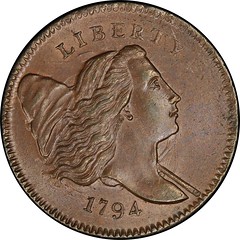
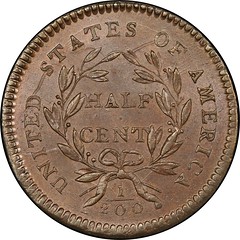
Published in Penny-Wise beginning in January 1974 and continuing until September 1977, Milton Pfeffer’s remarkably thorough survey of appearances of half cents covered nearly 2,500 auction catalogs found in the library of the American Numismatic Society. He identified just three appearances of specimens of this variety that had been described as Uncirculated in sales earlier than the private sale of the Howard Newcomb half cent collection to Col. E.H.R. Green. One of them was in the legendary June 1924 Alvord sale as lot 22, described as “Uncirculated. Splendid impression with beautiful light brown color. Very rare state.” Sadly, the coin was not among those depicted on the five photographic plates, but it was evidently quite beautiful: lot 22 brought $38.50, more than the prices of the first three 1793s combined and more than the 1796 With Pole. The piece in Thomas Elder’s April 1925 sale (lot 2148) was described similarly, “Uncirculated, light brown. A gem, seldom equalled.” Pfeffer’s other reference is to an April 1923 Elder catalog, but no such sale exists; we have not tracked down the sale he intended. It is possible, given the timing and the language, that all of these references are to the same coin. Without the benefit of photographic plates (or first-person documentation), it will be impossible to prove that this coin is the Alvord specimen, but that seems likely. Newcomb acquired at least one other Alvord coin, a Mint State 1793 C-1 that Newcomb purchased from Henry Chapman after the sale.
To read the complete lot description, see:
Lot 3015: 1793 Flowing Hair Cent. Sheldon-9 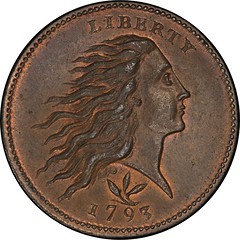
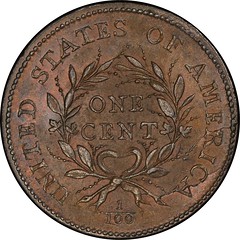
Even though the Sheldon-9 is lodged in the middle of Crosby and Sheldon’s descriptive sequence, modern research suggests this is one of two varieties with a claim to have been the first Wreath cent struck. The obverses and reverses of the 1793 cents were impeccably described by Crosby in 1897, well enough that Sheldon commented in Penny Whimsy that “Crosby’s book was so accurate and complete that in the half century since its publication no further varieties of 1793 have been found.” Ironically, it took until the age of encapsulation for researchers to pay proper attention to edges. In a paper that arose from the study of the Strawberry Leaf cents, Jim Neiswinter published observations made in concert with Dan Holmes, Bob Grellman, and then-current and former ANS curators Robert Hoge and John Kleeberg regarding the edge dies of 1793 cents. His article appeared in the March 2005 issue of Penny-Wise, following comparison of the two Strawberry Leaf cents owned by Dan Holmes to the Parmelee specimen, when on consignment to American Numismatic Rarities in 2004, and the specimen owned by the ANS. Neiswinter et al discovered that all Wreath cents except for Sheldon-8 and Sheldon-9 shared the same edge die. The Strawberry Leaf cents likewise shared this device. The Sheldon-8 and Sheldon-9 edge device was produced from the same edge die that milled the edges of all Chain cents that were studied, including Sheldon-1 through Sheldon-4 and 1793 NC-1. This edge evidence confirms that the planchets used to strike Sheldon-8 and Sheldon-9 were milled before the planchets used for the other Wreath cents, prior to the edge dies being changed in the Castaing machine (also known as an edge mill). While the first planchets prepared do not necessarily need to have been the first planchets struck, the evidence Bill Eckberg published in Penny-Wise in September 2010 is persuasive. The coiner’s account book consulted by Eckberg, discovered in the National Archives by Craig Sholley, shows that while Wreath cent planchets were being milled from April 3 to April 6, Wreath cent coining began on April 4, confirming that the final Wreath cent planchets to be milled were among the last to be struck. Eckberg posits that the milling process had begun a few days before April 3, but the surviving documentation begins on that date; the earlier account book has not been found. Eckberg’s 2010 study also delved into emission sequences and die states. Sheldon-8 and Sheldon-9 share an obverse die, but the die state of that obverse is always later on Sheldon-8 than on Sheldon-9. This obverse, Crosby’s Obverse 9, was also used on 1793 NC-4, but all four survivors of that variety are too low grade to determine their die state. Gathering the die state evidence and the edge die evidence, the data strongly suggests that either NC-4 or Sheldon-9 was the first Wreath cent struck.
To read the complete lot description, see:
Lot 3132: 1807 Capped Bust Left Half Eagle 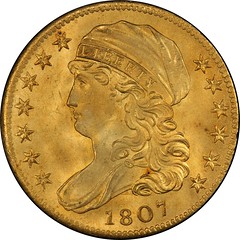

The beginning of the Capped Bust design type in 1807 heralds the appointment of engraver John Reich to a permanent position the United States Mint. Reich first arrived in Philadelphia from Germany in 1800. A year later, he performed his first work for the Mint, executing the dies of the 1801 Thomas Jefferson inaugural medal that also served to commemorate the 25th anniversary of the Declaration of Independence. After several years assisting with medals by contract, Reich was finally hired as a full time engraver at the Mint on April 1, 1807. He began working immediately. On April 3, Mint Director Robert Patterson wrote to Thomas Jefferson that “Mr. Reich is now preparing a set of new dies, in which some improvements in the devices will be introduced (adhering, however, strictly to the letter of the law) which it is hoped will meet with public approbation.” The dies, undoubtedly master dies of this new design, could have been those for half dollars or half eagles. Mint Director James Ross Snowden wrote in 1860, “if our conclusions be correct, the first issue of coins of the new type took place on the 30th of September, and consisted of 15,967 half eagles.” He added in a footnote that “there was no gold of any kind coined at the Mint after the middle of June, until this time,” referring to the late September delivery of half eagles. Just two varieties of Capped Bust half eagles were coined before the end of 1807, struck from the same obverse die and two different reverse dies. The first reverse die developed a crack and was replaced by this one, which was also used for the first two die marriages of 1808. Snowden’s math has turned out to be inaccurate in retrospect, and modern authorities agree on a total mintage figure of 51,605 1807 half eagles of this type. Most of them were from this die marriage.
To read the complete lot description, see:
Harvey Stack wrote to recommend the new video by CoinWeek on the Pogue III lots, featuring an interview with Vicken Yegparian of Stack's Bowers.
-Editor
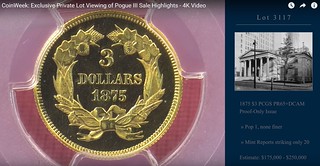
Stack’s Bowers gave CoinWeek readers an exclusive private lot viewing of some of the the rarest and most important coins from the upcoming third sale of the coins of the D. Brent Pogue Family Rare Coin Cabinet. The Pogue Collection is the most valuable collection of U.S. coins ever assembled, and quite possibly the most important collection of coins assembled in the past 50 years. On February 9, 2016, Stack’s Bowers and Sotheby’s will team up once again to offer collectors the unprecedented opportunity to acquire more than a hundred of the finest known surviving examples of United States half cents, large cents, dimes, half dollars, three dollar, and five dollar gold.
To view the complete video, see:
THE BOOK BAZARREWayne Homren, Editor The Numismatic Bibliomania Society is a non-profit organization promoting numismatic literature. See our web site at coinbooks.org. To submit items for publication in The E-Sylum, write to the Editor at this address: whomren@gmail.com To subscribe go to: https://my.binhost.com/lists/listinfo/esylum All Rights Reserved. NBS Home Page Contact the NBS webmaster 
|